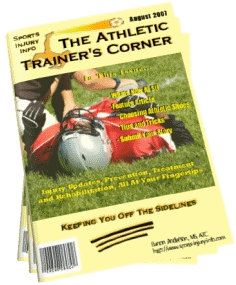ACL Reconstruction:
What to Expect

You had an ACL reconstruction.
And
now you have a swollen knee.
A painful knee.
And
so many questions.
Your
knee, after an ACL surgery will feel like it doesn't even belong
to you. It will feel foreign, and it will be frustrating.
Knowing
what to expect before surgery will better prepare you for after
surgery. Read on to find out about some of the things you will
experience after acl surgery.
Pain
I wish
I could tell you that it wasn't painful. I would be lying. ACL
reconstruction, whether with a
patellar tendon graft,
hamstring graft,
or other donor
tissue is painful.
With
my patients I use a scale of 0-10 to rate pain levels. 0 is no pain at
all, and 10 is the worst pain ever felt in your life. On average, my
patients rate their pain, 4-5 days after surgery when they come in, at
a 6 or 7 out of 10. So, in general, ACL reconstructions have a moderate
pain level.
Is it Really My Leg?
Probably
the
wierdest and most frustrating part of the post ACL reconstruction
period is the fact that your quadriceps muscle just won't work.
You try to contract it as hard as you can, and it just doesn't
listen. Not even a flicker of contraction.
This is
completely
normal. Frustrating, but normal. You will also notice that when you
compare your surgery leg with your other leg, the surgery leg looks
smaller.
So why does the quadriceps seem to
shrink, and won't respond to your contraction attempts? Its all about
the swelling.
When
the joint swells, the capsule becomes distended and stretched. Your
body's first reaction is to try to protect the knee. So, it turns the
quadriceps off...just like flipping a switch.
When
your body
turns off the quadriceps, you lose the ability to contract it. So, it
just sits there, unresponsive. It also loses its normal muscle tone.
Muscle tone is what gives our muscles shape. It is a constant small
amount of contraction within the muscles. Your non surgery leg still
has its normal tone, so it appears bigger.
Numbness

You
will notice an area of numbness along the outside of the knee.
This
is especially true if you have a patellar tendon graft ACL
reconstruction. This numb area varies in size from person to person.
The
small nerve that supplies sensation to the skin on the outside of the
knee runs right across the front of the knee.
Unfortunately,
they must cut through this superficial nerve to get to the patellar
tendon. Which results in numbness on the outside of the knee.
This
area will shrink in size over time, but you will always have a small
area of numbness or altered sensation.
Bruising
It
is very common to have bruising around the knee and leg. As the
bleeding from the surgery moves to the surface, it becomes visible.
Gravity will pull some of this fluid down the leg, and you may have
areas of discoloration in the shin or even in the ankle.
Just
because there is discoloration doesn't mean there is damage there. It
is just where the blood ends up.
What is This Yellow Stuff?
Most
surgeries require a signficant amount of sterile preparation before any
cuts are made. Betadine, or other types of anesceptic scrubs are used
up and down the leg to make sure that the area is very clean and
sterile.
Betadine, or the yellow discoloration that
you see all
over your leg after surgery doesn't come off easily with simple soap
and water. The secret is to use rubbing alcohol to get rid of it. You
may still have to scrub a little, but it will come off.
ACL Surgery Stories
If you have had an ACL reconstruction, or are getting ready for this surgery, I want to hear your story. Whether you have questions you want answered, or just want to share your experience, this is the place for you.
Summary
The list above is not comprehensive, but it covers the most common questions I hear after ACL reconstructions. If you have other questions, please feel free to use the contact button on the upper left to send me your questions.
Didn't find what you were looking for? Search SII for more information...Running Pain Solutions
Written for Runners by a runner, you'll learn a holistic approach to improving mobility, restoring normal movement and muscle activation patterns, and restoring the body and mind connection.
This Kindle Book contains a step by step program to keep you running pain free. Included are detailed instructions and illustrations for exercises to improve mobility, balance, neuromuscular control, strength and endurance. Only $7.49!
Get Your Copy Today!









